Dynamic Tensile Behavior of Laser-Directed Energy Deposition and Additive Friction Stir-Deposited AerMet 100
Abstract
:1. Introduction
2. Materials and Methods
3. Results and Discussion
4. Conclusions
- The overall microstructure and strain-rate dependance was studied and revealed a positive relationship, with an increasing strain rate for both the L-DED- and AFSD-deposited materials.
- The L-DED results matched well with those reported in the literature
- The current work is the first to report on the mechanical performance and strain-rate sensitivity of AFSD AerMet 100.
- The L-DED-deposited materials displayed average YS and UTS values of 1075, 1835, and 2282, 2902 MPa for the 0.001 s−1 and 2500 s−1 strain rates, respectively.
- The AFSD-deposited materials displayed YS and UTS values of 982, 1928, and 2189, and 3080 MPa for the 0.001 s−1 and 2500 s−1 strain rates, respectively.
- Fractography revealed defects associated with the manufacturing process in both the AFSD and L-DED materials, with large solidification voids in the L-DED and delamination from poor layer adhesion in the AFSD.
- Electron backscatter diffraction and scanning electron microscopy revealed a mostly bainitic structure for the L-DED material and a split bainitic and austenitic structure for the AFSD material, with a slightly smaller grain size in the AFSD.
- Overall, the L-DED- and AFSD-deposited materials exhibited very similar mechanical behaviors with only a difference of 4% at the high rate. However, both the AFSD and the L-DED processes fell short of the wrought AerMet 100 yield strength and ultimate tensile strength specification. Future work investigating the use of a post-deposition heat treatment to increase the mechanical performance is required.
- Future study of material mechanical properties in the z-direction are also needed to better understand and utilize the different additive manufacturing processes, as well as aid in the calibration of a constitutive model that would be useful in numerical simulations to leverage the technologies.
Author Contributions
Funding
Data Availability Statement
Acknowledgments
Conflicts of Interest
References
- Zheng, P.; Wang, H.; Sang, Z.; Zhong, R.Y.; Liu, Y.; Liu, C.; Mubarok, K.; Yu, S.; Xu, X. Smart Manufacturing Systems for Industry 4.0: Conceptual Framework, Scenarios, and Future Perspectives. Front. Mech. Eng. 2018, 13, 137–150. [Google Scholar] [CrossRef]
- Galantucci, L.M.; Guerra, M.G.; Dassisti, M.; Lavecchia, F. Additive Manufacturing: New Trends in the 4th Industrial Revolution. In Proceedings of the 4th International Conference on the Industry 4.0 Model for Advanced Manufacturing, Belgrade, Serbia, 3–6 June 2019; Monostori, L., Majstorovic, V.D., Hu, S.J., Djurdjanovic, D., Eds.; Lecture Notes in Mechanical Engineering. Springer International Publishing: Cham, Switzerland, 2019; pp. 153–169, ISBN 978-3-030-18179-6. [Google Scholar]
- ISO/ASTM 52900:2021; Additive Manufacturing—General Principles—Fundamentals and Vocabulary. BSI British Standards: Jersey, UK, 2021.
- Jeong, W.; Kwon, Y.-S.; Kim, D. Three-Dimensional Printing of Tungsten Structures by Directed Energy Deposition. Mater. Manuf. Process. 2019, 34, 986–992. [Google Scholar] [CrossRef]
- Wang, Y.; Shi, J. Microstructure and Properties of Inconel 718 Fabricated by Directed Energy Deposition with In-Situ Ultrasonic Impact Peening. Metall. Mater. Trans. B 2019, 50, 2815–2827. [Google Scholar] [CrossRef]
- Saboori, A.; Biamino, S.; Lombardi, M.; Tusacciu, S.; Busatto, M.; Lai, M.; Fino, P. How the Nozzle Position Affects the Geometry of the Melt Pool in Directed Energy Deposition Process. Powder Metall. 2019, 62, 213–217. [Google Scholar] [CrossRef]
- Ganesh, P.; Moitra, A.; Tiwari, P.; Sathyanarayanan, S.; Kumar, H.; Rai, S.K.; Kaul, R.; Paul, C.P.; Prasad, R.C.; Kukreja, L.M. Fracture Behavior of Laser-Clad Joint of Stellite 21 on AISI 316L Stainless Steel. Mater. Sci. Eng. A 2010, 527, 3748–3756. [Google Scholar] [CrossRef]
- Sun, S.D.; Liu, Q.; Brandt, M.; Luzin, V.; Cottam, R.; Janardhana, M.; Clark, G. Effect of Laser Clad Repair on the Fatigue Behaviour of Ultra-High Strength AISI 4340 Steel. Mater. Sci. Eng. A 2014, 606, 46–57. [Google Scholar] [CrossRef]
- Alam, M.M.; Kaplan, A.F.H.; Tuominen, J.; Vuoristo, P.; Miettinen, J.; Poutala, J.; Näkki, J.; Junkala, J.; Peltola, T.; Barsoum, Z. Analysis of the Stress Raising Action of Flaws in Laser Clad Deposits. Mater. Des. 2013, 46, 328–337. [Google Scholar] [CrossRef]
- Hazra, M.; Mondal, A.K.; Kumar, S.; Blawert, C.; Dahotre, N.B. Laser Surface Cladding of MRI 153M Magnesium Alloy with (Al + Al2O3). Surf. Coat. Technol. 2009, 203, 2292–2299. [Google Scholar] [CrossRef]
- Rivera, O.G.; Allison, P.G.; Jordon, J.B.; Rodriguez, O.L.; Brewer, L.N.; McClelland, Z.; Whittington, W.R.; Francis, D.; Su, J.; Martens, R.L.; et al. Microstructures and Mechanical Behavior of Inconel 625 Fabricated by Solid-State Additive Manufacturing. Mater. Sci. Eng. A 2017, 694, 1–9. [Google Scholar] [CrossRef]
- Rutherford, B.A.; Avery, D.Z.; Phillips, B.J.; Rao, H.M.; Doherty, K.J.; Allison, P.G.; Brewer, L.N.; Jordon, J.B. Effect of Thermomechanical Processing on Fatigue Behavior in Solid-State Additive Manufacturing of Al-Mg-Si Alloy. Metals 2020, 10, 947. [Google Scholar] [CrossRef]
- Phillips, B.J.; Avery, D.Z.; Liu, T.; Rodriguez, O.L.; Mason, C.J.T.; Jordon, J.B.; Brewer, L.N.; Allison, P.G. Microstructure-Deformation Relationship of Additive Friction Stir-Deposition Al–Mg–Si. Materialia 2019, 7, 100387. [Google Scholar] [CrossRef]
- Avery, D.Z.; Phillips, B.J.; Mason, C.J.T.; Palermo, M.; Williams, M.B.; Cleek, C.; Rodriguez, O.L.; Allison, P.G.; Jordon, J.B. Influence of Grain Refinement and Microstructure on Fatigue Behavior for Solid-State Additively Manufactured Al-Zn-Mg-Cu Alloy. Metall. Mater. Trans. A 2020, 51, 2778–2795. [Google Scholar] [CrossRef]
- Gopan, V.; Leo Dev Wins, K.; Surendran, A. Innovative Potential of Additive Friction Stir Deposition among Current Laser Based Metal Additive Manufacturing Processes: A Review. CIRP J. Manuf. Sci. Technol. 2021, 32, 228–248. [Google Scholar] [CrossRef]
- Garrison, W.M. Ultrahigh-Strength Steels for Aerospace Applications. JOM 1990, 42, 20–24. [Google Scholar] [CrossRef]
- Yoo, C.H.; Lee, H.M.; Chan, J.W.; Morris, J.W. M2C Precipitates in Isothermal Tempering of High Co-Ni Secondary Hardening Steel. Metall. Mater. Trans. A 1996, 27, 3466–3472. [Google Scholar] [CrossRef]
- Ayer, R.; Machmeier, P.M. Microstructural Basis for the Effect of Chromium on the Strength and Toughness of AF1410-Based High Performance Steels. Metall. Mater. Trans. A 1996, 27, 2510–2517. [Google Scholar] [CrossRef]
- Ayer, R.; Machmeier, P.M. Transmission Electron Microscopy Examination of Hardening and Toughening Phenomena in Aermet 100. Metall. Mater. Trans. A 1993, 24, 1943–1955. [Google Scholar] [CrossRef]
- Ayer, R.; Machmeier, P. On the Characteristics of M2C Carbides in the Peak Hardening Regime of AerMet 100 Steel. Metall. Mater. Trans. A 1998, 29, 903–905. [Google Scholar] [CrossRef]
- Ran, X.; Zhang, S.; Liu, D.; Tang, H.; Wang, H. Role of Microstructural Characteristics in Combination of Strength and Fracture Toughness of Laser Additively Manufactured Ultrahigh-Strength AerMet100 Steel. Metall. Mater. Trans. A 2021, 52, 1248–1259. [Google Scholar] [CrossRef]
- Reinhart, W.D. Dynamic Yield Strength and Spall Strength Determination for AerMet® 100 Steels. In Proceedings of the AIP Conference Proceedings; AIP: Snowbird, UT, USA, 2000; Volume 505, pp. 471–474. [Google Scholar]
- Boyce, B.L.; Dilmore, M.F. The Dynamic Tensile Behavior of Tough, Ultrahigh-Strength Steels at Strain-Rates from 0.0002s−1 to 200s−1. Int. J. Impact Eng. 2009, 36, 263–271. [Google Scholar] [CrossRef]
- Hu, D.Y.; Meng, K.P.; Jiang, H.L.; Xu, J.; Liu, R.R. Strain Rate Dependent Constitutive Behavior Investigation of AerMet 100 Steel. Mater. Des. 2015, 87, 759–772. [Google Scholar] [CrossRef]
- Ran, X.; Liu, D.; Li, A.; Wang, H.; Tang, H.; Cheng, X. Microstructure Characterization and Mechanical Behavior of Laser Additive Manufactured Ultrahigh-Strength AerMet100 Steel. Mater. Sci. Eng. A 2016, 663, 69–77. [Google Scholar] [CrossRef]
- Ran, X.; Liu, D.; Li, J.; Liu, X.; Wang, H.; Cheng, X.; He, B.; Tang, H. Effects of Post Homogeneity Heat Treatment Processes on Microstructure Evolution Behavior and Tensile Mechanical Properties of Laser Additive Manufactured Ultrahigh-Strength AerMet100 Steel. Mater. Sci. Eng. A 2018, 723, 8–21. [Google Scholar] [CrossRef]
- Lu, Y.; Wang, G.; Zhang, M.; Li, R.; Zhang, H. Microstructures, Heat Treatments and Mechanical Properties of AerMet100 Steel Fabricated by Hybrid Directed Energy Deposition. Addit. Manuf. 2022, 56, 102885. [Google Scholar] [CrossRef]
- Aditya, Y.N.; Dharish Srichandra, T.; Tak, M.; Padmanabham, G. To Study the Laser Cladding of Ultra High Strength AerMet-100 Alloy Powder on AISI-4340 Steel for Repair and Refurbishment. Mater. Today Proc. 2021, 41, 1146–1155. [Google Scholar] [CrossRef]
- Li, K.; Yang, T.; Gong, N.; Wu, J.; Wu, X.; Zhang, D.Z.; Murr, L.E. Additive Manufacturing of Ultra-High Strength Steels: A Review. J. Alloys Compd. 2023, 965, 171390. [Google Scholar] [CrossRef]
- Francis, D.K.; Whittington, W.R.; Lawrimore, W.B.; Allison, P.G.; Turnage, S.A.; Bhattacharyya, J.J. Split Hopkinson Pressure Bar Graphical Analysis Tool. Exp. Mech. 2017, 57, 179–183. [Google Scholar] [CrossRef]
- Vilar, R. Laser Cladding. J. Laser Appl. 1999, 11, 64–79. [Google Scholar] [CrossRef]
- Sun, S.D.; Leary, M.; Liu, Q.; Brandt, M. Evaluation of Microstructure and Fatigue Properties in Laser Cladding Repair of Ultrahigh Strength AerMet ® 100 Steel. J. Laser Appl. 2015, 27, S29202. [Google Scholar] [CrossRef]
- Jelis, E.; Hespos, M.R.; Feurer, M.; Groeschler, S. Development of Laser Powder Bed Fusion Processing Parameters for Aermet 100 Powder. J. Mater. Eng. Perform. 2023, 32, 7195–7203. [Google Scholar] [CrossRef]
- Chouhan, A.; Aggarwal, A.; Kumar, A. A Computational Study of Porosity Formation Mechanism, Flow Characteristics and Solidification Microstructure in the L-DED Process. Appl. Phys. A 2020, 126, 833. [Google Scholar] [CrossRef]
- Shao, J.; Samaei, A.; Xue, T.; Xie, X.; Guo, S.; Cao, J.; MacDonald, E.; Gan, Z. Additive Friction Stir Deposition of Metallic Materials: Process, Structure and Properties. Mater. Des. 2023, 234, 112356. [Google Scholar] [CrossRef]
- Vaezi, M.; Drescher, P.; Seitz, H. Beamless Metal Additive Manufacturing. Materials 2020, 13, 922. [Google Scholar] [CrossRef] [PubMed]
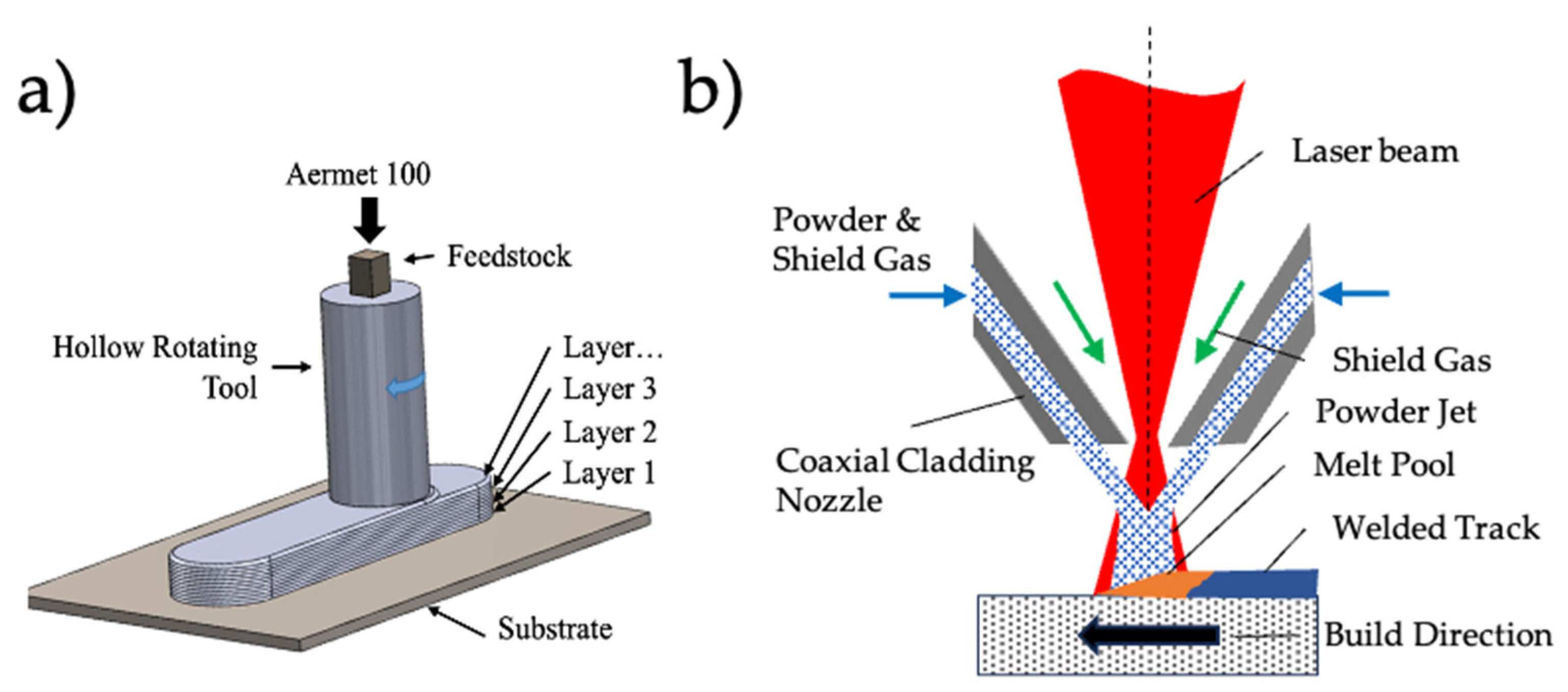


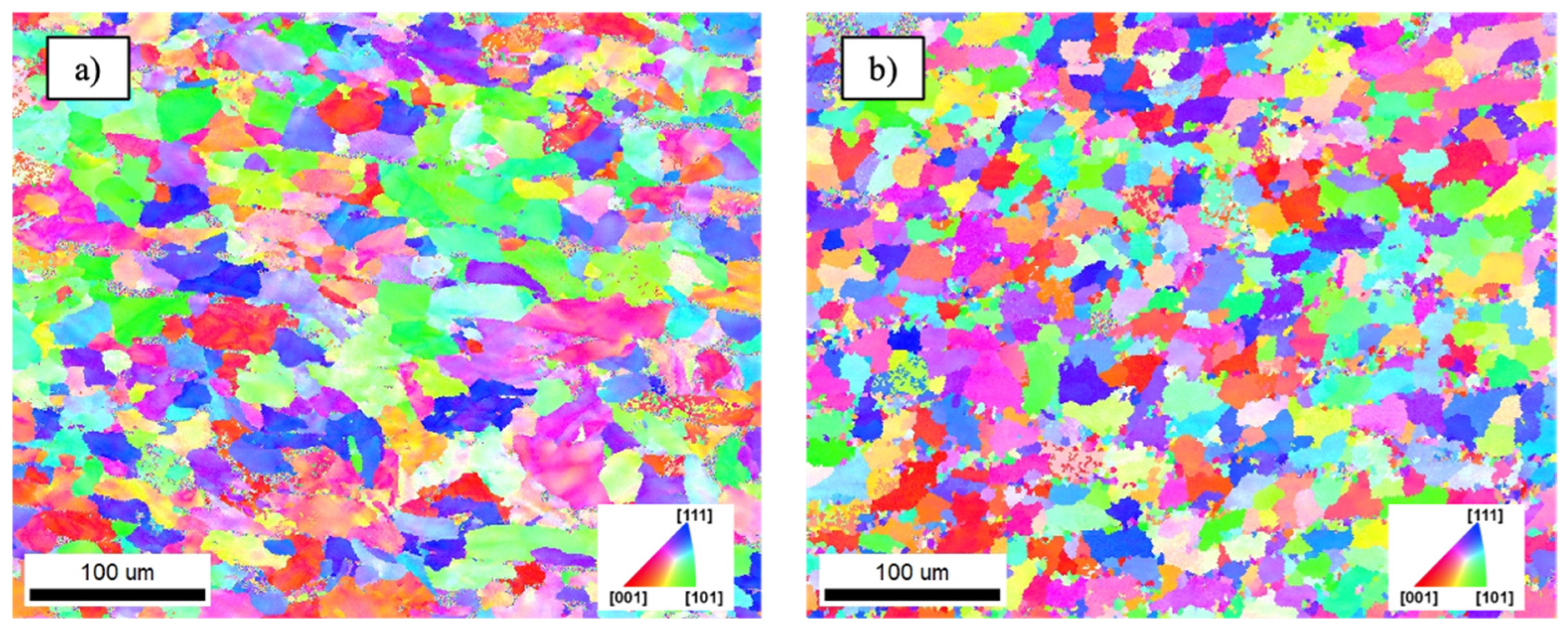
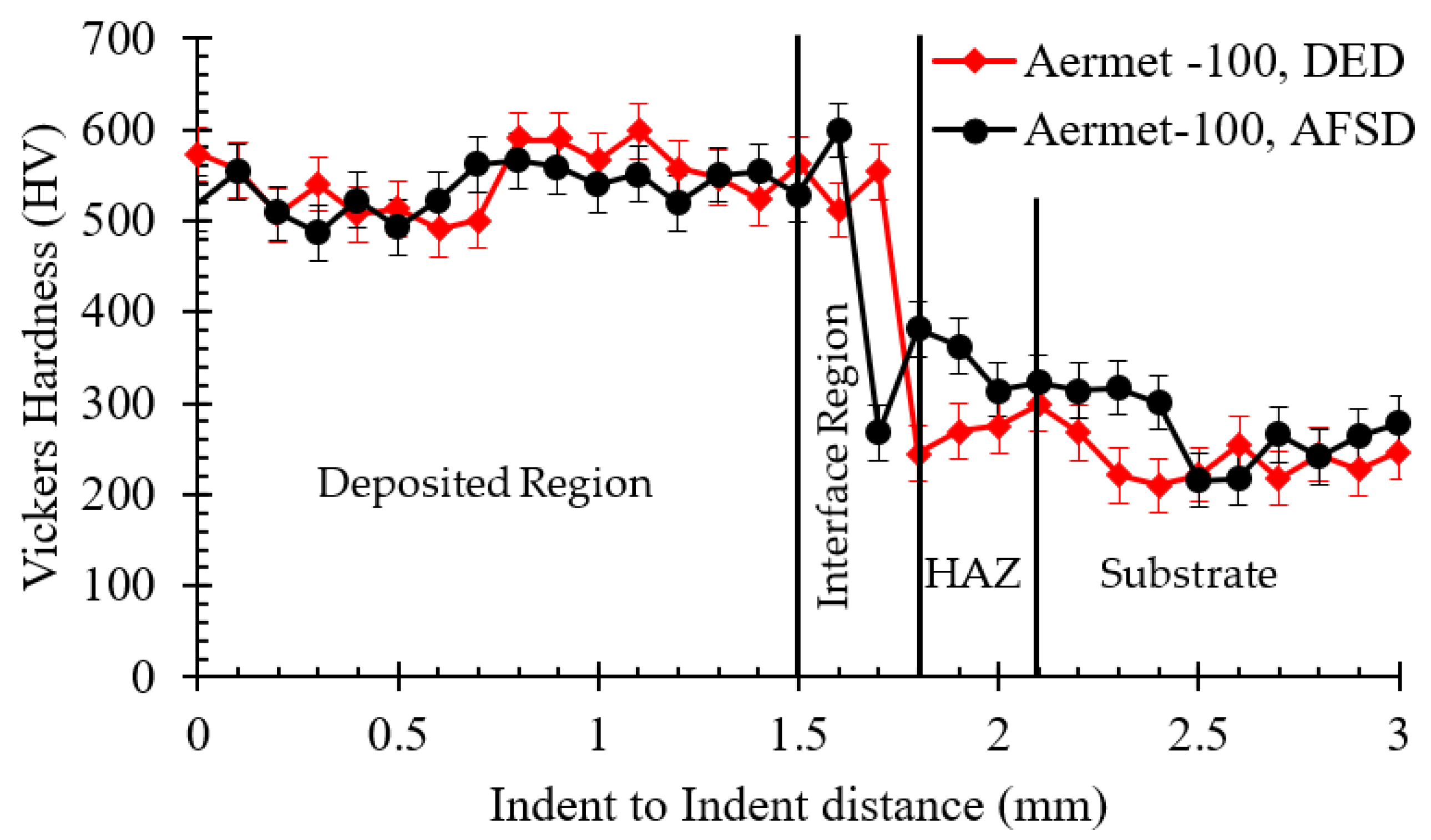
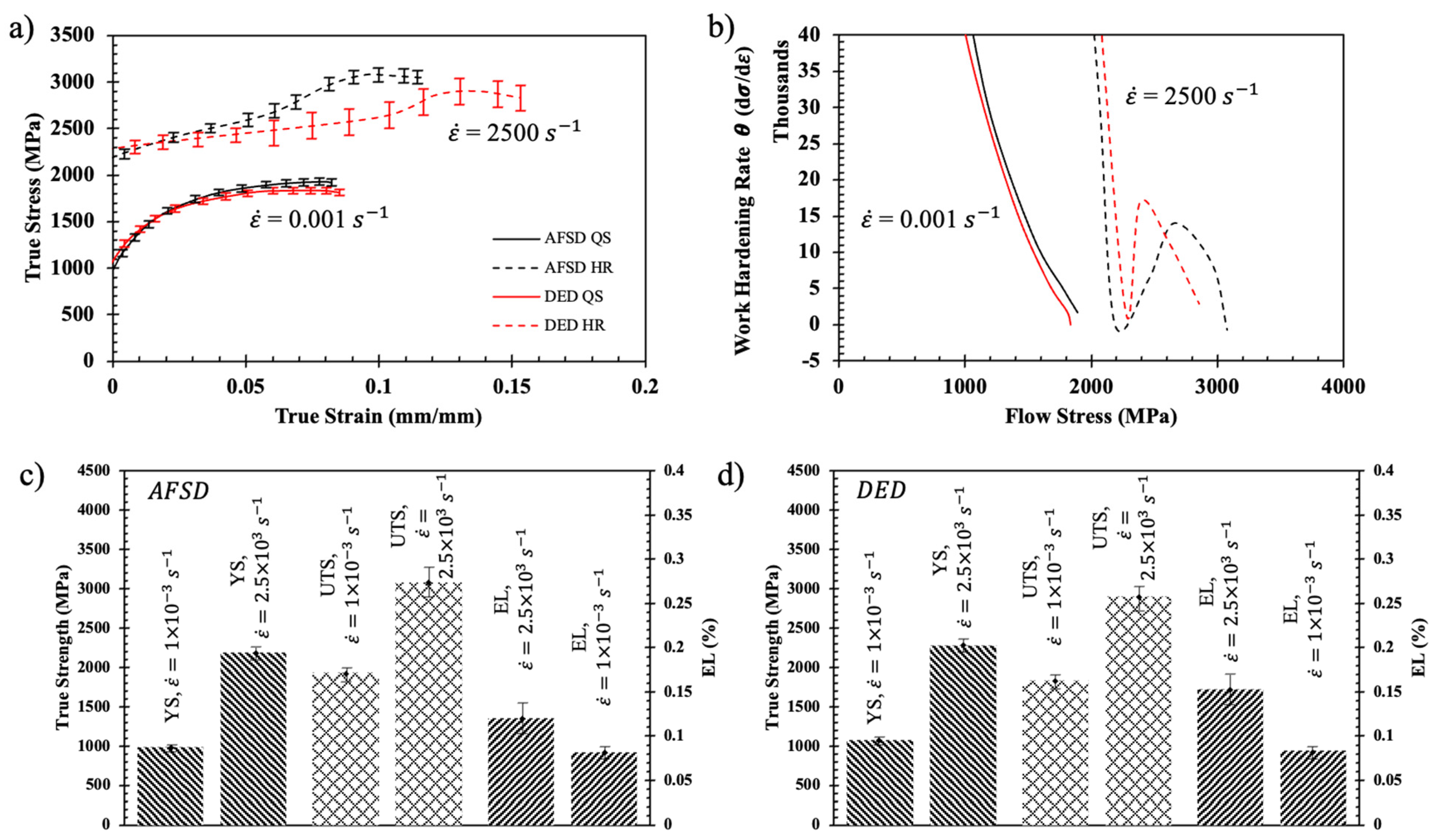
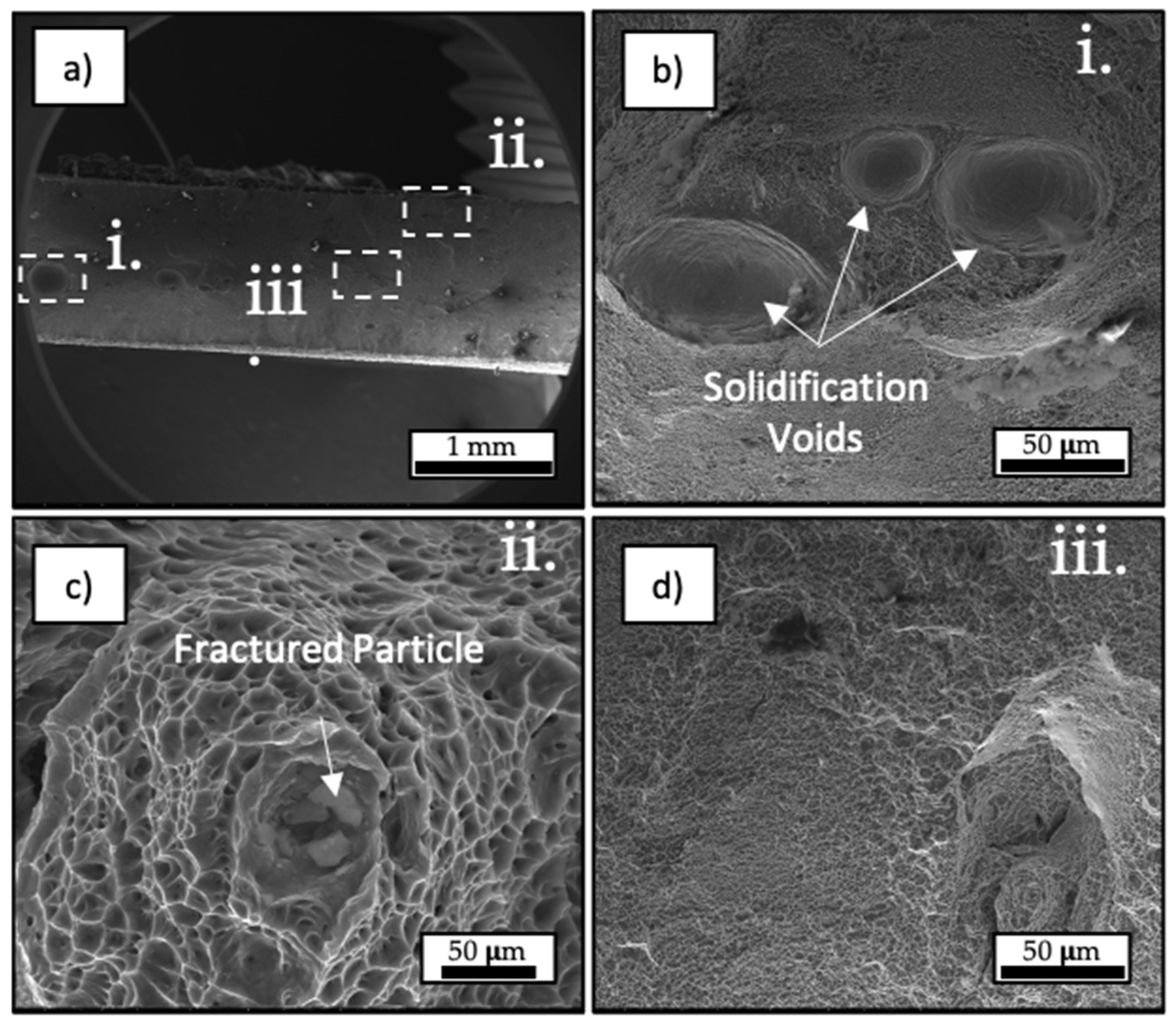

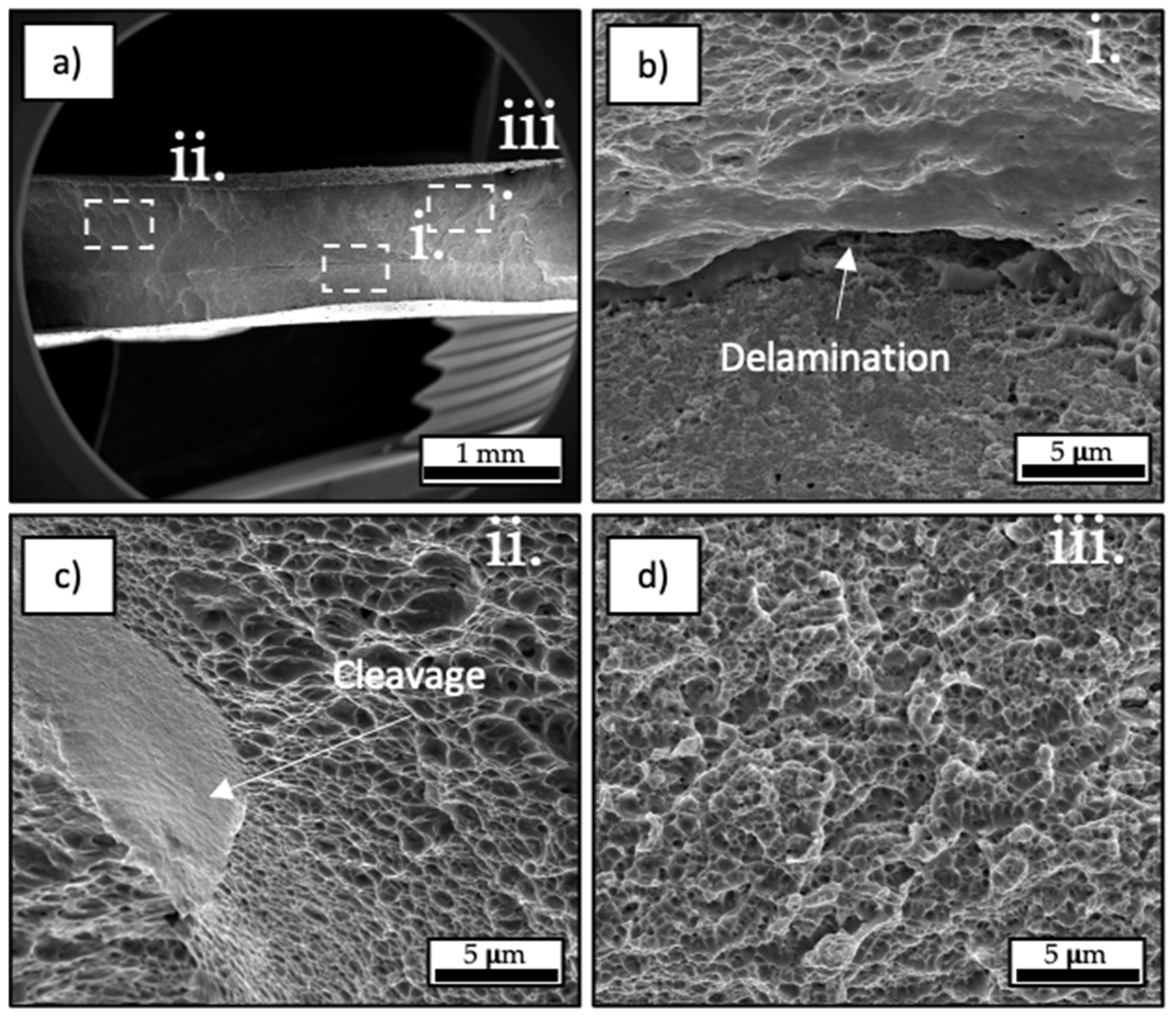
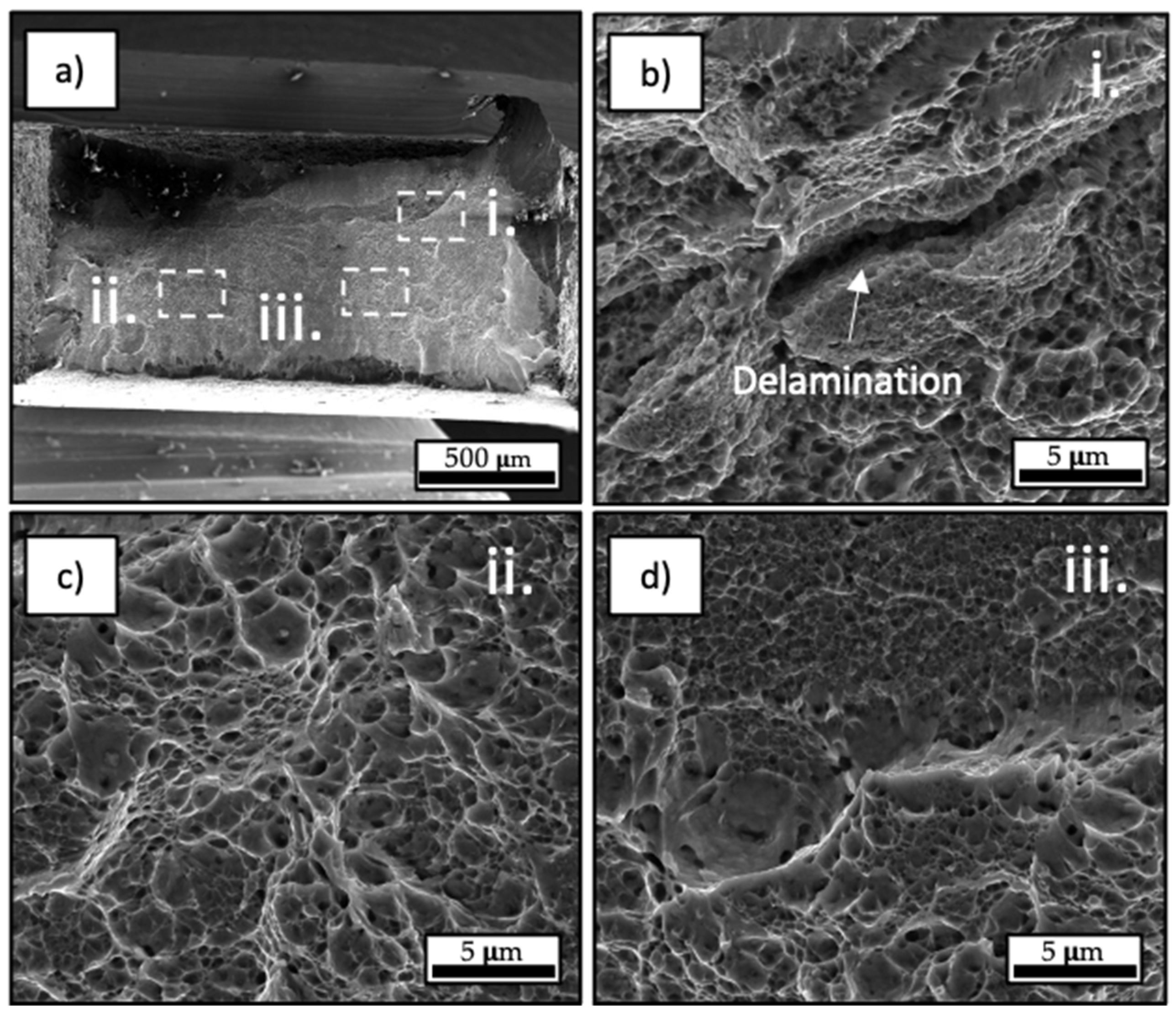
| Condition | YS (MPa) | UTS (MPa) | EL (%) |
|---|---|---|---|
| Wrought | 1690 | 2000 | 8 |
| Laser-Directed Energy Deposited AerMet 100 [25] | 1062 | 1583 | 12.3 |
| Laser-Directed Energy Deposited AerMet 100 [32] | 1009 | 1655 | 6.8 |
| Wire Arc Additive Manufactured AerMet 100 [27] | 1232 | 1903 | 8–14 |
| Laser Powder Bed Fusion as Built, Stress-Relieved [33] | 1356 | 1665 | 13.8 |
| AFSD AerMet 100 Current Study QS | 982 | 1928 | 8.2 |
| AFSD AerMet 100 Current Study HR | 2189 | 3080 | 12 |
| Laser-Directed Energy Deposited Current Study QS | 1075 | 1835 | 8.4 |
| Laser-Directed Energy Deposited Current Study HR | 2282 | 2902 | 15 |
Disclaimer/Publisher’s Note: The statements, opinions and data contained in all publications are solely those of the individual author(s) and contributor(s) and not of MDPI and/or the editor(s). MDPI and/or the editor(s) disclaim responsibility for any injury to people or property resulting from any ideas, methods, instructions or products referred to in the content. |
© 2023 by the authors. Licensee MDPI, Basel, Switzerland. This article is an open access article distributed under the terms and conditions of the Creative Commons Attribution (CC BY) license (https://creativecommons.org/licenses/by/4.0/).
Share and Cite
McClelland, Z.; Petersen, H.; Dunsford, K. Dynamic Tensile Behavior of Laser-Directed Energy Deposition and Additive Friction Stir-Deposited AerMet 100. Metals 2023, 13, 1736. https://doi.org/10.3390/met13101736
McClelland Z, Petersen H, Dunsford K. Dynamic Tensile Behavior of Laser-Directed Energy Deposition and Additive Friction Stir-Deposited AerMet 100. Metals. 2023; 13(10):1736. https://doi.org/10.3390/met13101736
Chicago/Turabian StyleMcClelland, Zackery, Haley Petersen, and Kyle Dunsford. 2023. "Dynamic Tensile Behavior of Laser-Directed Energy Deposition and Additive Friction Stir-Deposited AerMet 100" Metals 13, no. 10: 1736. https://doi.org/10.3390/met13101736




